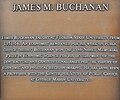Landis Green
Rests in the center of the campus as a student hub and area for recreation. Located in the center of the Florida State campus, Landis Green rests in front of the Landis Hall dormitory. Both hold their names after Cary D. Landis, who served as the Attorney General for Florida from 1931 to 1938. The Green serves as both an aesthetic place on the campus and as a location for student recreational activities throughout the year. Within the Green is the Legacy Fountain that saw construction in 2005, much later than the establishment of the green in 1931, though the green did not see its formal name until 1936. The university's Strozier Library rests opposite from the dormitory on the other end of the green, allowing the green to act as a further hub for students and faculty.
This page is based on this
Wikipedia article Text is available under the
CC BY-SA 4.0 license; additional terms may apply.
Images, videos and audio are available under their respective licenses.

















